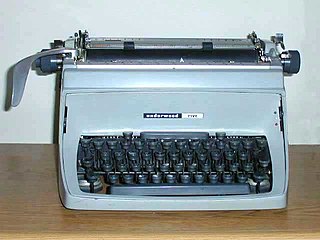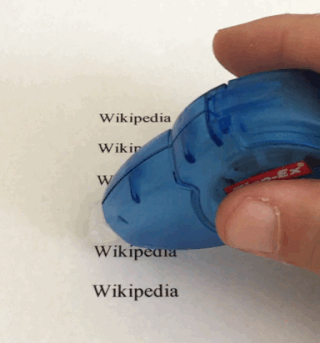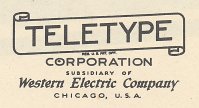
In computing, a printer is a peripheral machine which makes a persistent representation of graphics or text, usually on paper. While most output is human-readable, bar code printers are an example of an expanded use for printers. Different types of printers include 3D printers, inkjet printers, laser printers, and thermal printers.

A mimeograph machine is a low-cost duplicating machine that works by forcing ink through a stencil onto paper. The process is called mimeography, and a copy made by the process is a mimeograph.
TECO, short for Text Editor & Corrector, is both a character-oriented text editor and a programming language, that was developed in 1962 for use on Digital Equipment Corporation computers, and has since become available on PCs and Unix. Dan Murphy developed TECO while a student at the Massachusetts Institute of Technology (MIT).

A teleprinter is an electromechanical device that can be used to send and receive typed messages through various communications channels, in both point-to-point and point-to-multipoint configurations. Initially they were used in telegraphy, which developed in the late 1830s and 1840s as the first use of electrical engineering, though teleprinters were not used for telegraphy until 1887 at the earliest. The machines were adapted to provide a user interface to early mainframe computers and minicomputers, sending typed data to the computer and printing the response. Some models could also be used to create punched tape for data storage and to read back such tape for local printing or transmission.

A typewriter is a mechanical or electromechanical machine for typing characters. Typically, a typewriter has an array of keys, and each one causes a different single character to be produced on paper by striking an inked ribbon selectively against the paper with a type element. At the end of the nineteenth century, the term 'typewriter' was also applied to a person who used such a device.

Punched tape or perforated paper tape is a form of data storage that consists of a long strip of paper in which holes are punched. It developed from and was subsequently used alongside punched cards, differing in that the tape is continuous.

Dot matrix printing, sometimes called impact matrix printing, is a computer printing process in which ink is applied to a surface using a relatively low-resolution dot matrix for layout. Dot matrix printers typically use a print head that moves back and forth or in an up-and-down motion on the page and prints by impact, striking an ink-soaked cloth ribbon against the paper, much like the print mechanism on a typewriter or line printer. However, a dot matrix printer is able to print arbitrary patterns and not just specific characters.

Liquid Paper is an American brand of the Newell Brands company marketed internationally that sells correction fluid, correction pens, and correction tape. Mainly used to correct typewriting in the past, correction products now mostly cover handwriting mistakes.

Correction tape is an alternative to correction fluid used to correct mistakes during typing, or, in some forms, handwriting. One side of the tape, which is placed against the area to cover, is coated in a white, opaque masking material. Pressure applied to the other side of the tape transfers this material to the paper. Unlike correction fluid, the covered area can be written on it immediately after applying. As it is solid, correction tape is not subject to misuse as an inhalant, unlike most correction fluids.

A correction fluid is an opaque, usually white fluid applied to paper to mask errors in text. Once dried, it can be handwritten or typed upon. It is typically packaged in small bottles, lids attached to brushes that dip into the fluid. The brush applies the fluid to the paper.
Wite-Out is a registered trademark for a brand of correction fluid, originally created for use with photocopies, and manufactured by the BIC corporation.
Kyota Sugimoto was a Japanese inventor who developed the first practical Japanese typewriter. He received the Blue Ribbon Award and the Small Asahi Ribbon. Out of the thousands of kanji characters, Sugimoto's typewriter used 2,400 of them.

The Friden Flexowriter produced by the Friden Calculating Machine Company, was a teleprinter, a heavy-duty electric typewriter capable of being driven not only by a human typing, but also automatically by several methods, including direct attachment to a computer and by use of paper tape.

A keypunch is a device for precisely punching holes into stiff paper cards at specific locations as determined by keys struck by a human operator. Other devices included here for that same function include the gang punch, the pantograph punch, and the stamp. The term was also used for similar machines used by humans to transcribe data onto punched tape media.
Tipp-Ex is a brand of correction fluid and other related products that is popular throughout Europe. It was also the name of the German company that produced the products in the Tipp-Ex line. While Tipp-Ex is a trademark name for correction products, in some countries it has become a genericised trademark: to tippex or to tippex out means to erase, either generally or with correction fluid.

A label printer is a computer printer that prints on self-adhesive label material and/or card-stock (tags). A label printer with built-in keyboard and display for stand-alone use is often called a label maker. Label printers are different from ordinary printers because they need to have special feed mechanisms to handle rolled stock, or tear sheet (fanfold) stock. Common connectivity for label printers include RS-232 serial, Universal Serial Bus (USB), parallel, Ethernet and various kinds of wireless. Label printers have a wide variety of applications, including supply chain management, retail price marking, packaging labels, blood and laboratory specimen marking, and fixed assets management.

The Teletype Corporation, a part of American Telephone and Telegraph Company's Western Electric manufacturing arm since 1930, came into being in 1928 when the Morkrum-Kleinschmidt Company changed its name to the name of its trademark equipment. Teletype Corporation, of Skokie, Illinois, was responsible for the research, development and manufacture of data and record communications equipment, but it is primarily remembered for the manufacture of electromechanical teleprinters.

Kores is a brand of school stationery and office products best known for solid glue sticks, dry correction tapes and Kolores coloured pencils. Kores was founded in 1887 by Wilhelm Koreska, the great-grandfather of Clemens Koreska, the current president of Kores Group. The worldwide HQ of Kores is based in Vienna, Austria and its main offices are in Czech Republic (Prague), Germany (Rommerskirchen), Mexico, Colombia (Bogotá) and Venezuela (Caracas). Kores has two key production facilities in Mexico City and Strmilov.
The Olivetti company, an Italian manufacturer of computers, tablets, smartphones, printers and other such business products as calculators and fax machines, was founded as a typewriters manufacturer by Camillo Olivetti in 1908 in the Turin commune of Ivrea, Italy.

The IBM Selectric typewriter was a highly successful line of electric typewriters introduced by IBM on 31 July 1961.
















